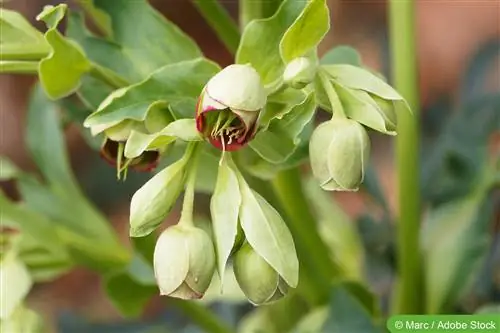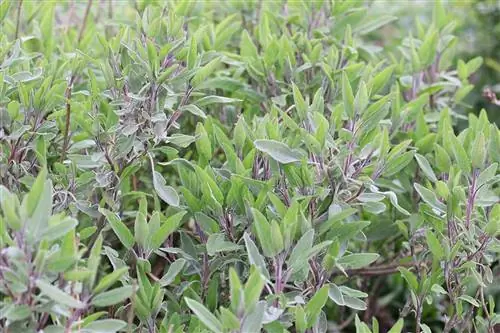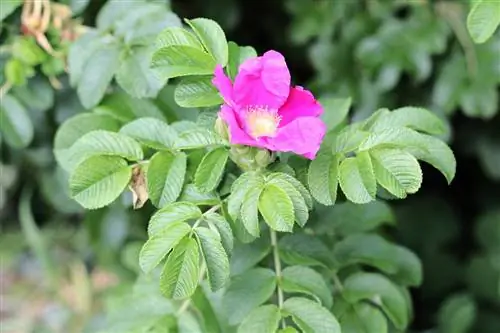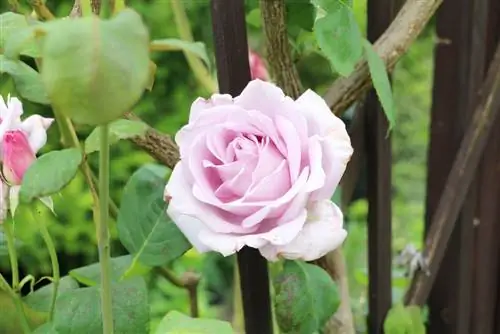- Author admin [email protected].
- Public 2023-12-17 03:39.
- Last modified 2025-01-24 12:45.
Many of the plants growing in nature or in the garden have amazing properties that very few people are aware of. They also include the stinking hellebore.
Ranunculus
The stinking hellebore (Helleborus foetidus) is a plant from the buttercup family. As its name suggests, the plant exudes a not very pleasant smell; the unpleasant odor rises from the leaves. The Latin name also refers to this property, foetida translates as “stinking”. Like other plants with this Latin term attached to their names, the stinking hellebore is attributed to the devil in the German translation. In addition to devil's weed, names such as bear's foot and fireweed, rogue's root or wolf's tooth are also known.
The stinking hellebore is native to central Europe and the south; it can hardly be found further east than here. It feels comfortable in forests and on the edge of the forest, and also likes to grow next to or under native bushes.
Smelly hellebore in the garden
Despite its unflattering nicknames, the stinking hellebore developed into a popular garden plant; There are not that many plants that produce flowers in winter in our latitudes. They also include the hellebore relative Christmas rose, which got the beautiful name from the winter blossom - it just smells better.
But the stinking hellebore has the advantage that of all the hellebore it copes best with sun and dry soil. It is the hardy plant for those who want evergreens and flowers in winter and never have any complaints. The size of the sub-shrubs also fits well into our gardens, 60 - 90 centimeters have space in the smallest front garden and don't get lost even in the park.
Care
- The stinking hellebore likes calcareous soil, preferably clay or loess, the soil should also be loose.
- He would rather have a lot of humidity than too little, at some point he can no longer stand extreme frosts.
- It prefers partial shade, which is why it is the ideal underplant for taller plants, which is how it grows in nature.
Otherwise, the stinking hellebore has few demands; it prefers to be left alone. It can resent being transplanted to a new location, as well as any soil improvement measures that come too close to its sensitive roots (hoeing, digging). The foliage of the plants above it does not need to be removed either; the hellebore is happy about this winter cover. However, it likes nutrients in the soil, and in addition to the soil-improving leaf cover, we recommend adding long-term flower fertilizer or compost in spring.
- When the hellebore feels comfortable, it often sows itself. Generally it produces several shoots that take some time to ripen.
- If the seeds are scattered, these shoots die. New side shoots form beforehand, which will soon produce new flowers.
- Flower beginnings usually appear in autumn, and the flowers then open from late winter to spring. Then they appear in clusters, mostly light green, occasionally with a reddish edge.
- The hellebore doesn't actually need to be pruned, you can only cut off unattractive leaves after flowering.
Smelly hellebore as a medicinal plant
The stinking hellebore was used as a medicinal plant in earlier folk medicine, for example as an emetic, as a laxative and as a worm cure.
Even though hellebore is still praised as a remedy in many places, it is no longer used medicinally today due to its toxic components. All parts of the plant are highly poisonous, and there are several poisons that cause problems for those seeking healing. Saponins, bufadienolide, protoanemonin, helleborein and aconitic acid are mentioned, with very contradictory statements about the exact composition of the ingredients. In any case, it contains digitalis-like substances that can lead to death due to respiratory paralysis.
But there are other types of hellebore that are more suitable for use as medicine. The Christmas rose (black hellebore) is used in homeopathy, albeit with similar care as the use of foxglove requires. An ingredient with anti-cancer properties was discovered in the white hellebore, which is native to the northwestern mountains of the USA.
Smelly hellebore as bee pasture
If you can't use the stinking hellebore for your own healing, at least it contributes to the healing of nature as a sought-after bee pasture. Because pollinating insects are becoming fewer and fewer, every pollinator contributes to biodiversity. The nice thing about it is that the nectar of the stinking hellebore is only accessible to bumblebees and fur bees due to the hanging shape of the flowers. The plant has even come up with a special trick by using yeast in the nectar to create friendly temperatures that attract freezing bumblebees.
The specialization in bumblebees and fur bees is nice because both types of insects are already under protection due to their rarity. An advantage for humans is that bumblebees and fur bees assert their territory against aggressive wasps, which are becoming fewer in these areas. Fur bees and bumblebees, on the other hand, only sting in extreme distress (for example if you grab them and threaten to crush them). And even then, the sting wouldn't be very serious because the stinger remains on the bumblebee and fur bee and not in the human skin, as with honey bees, where poison continues to escape. Allergy sufferers excluded, of course.
If you want to do even more for these lovely guests, you can also plant lungwort in the garden, it is their favorite pasture.






